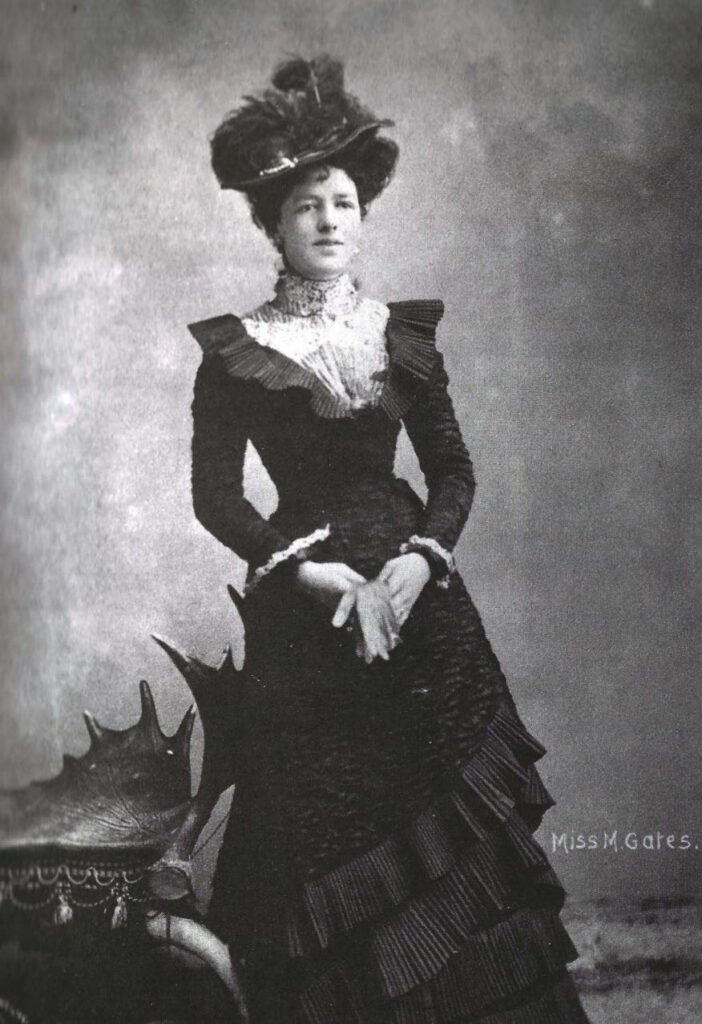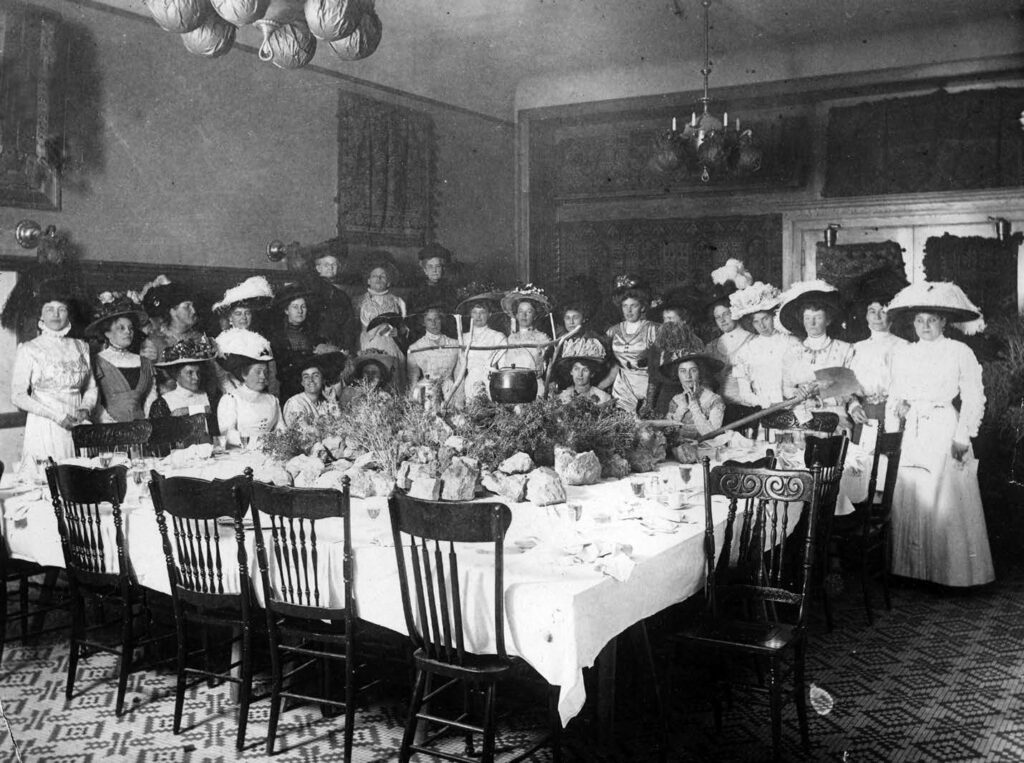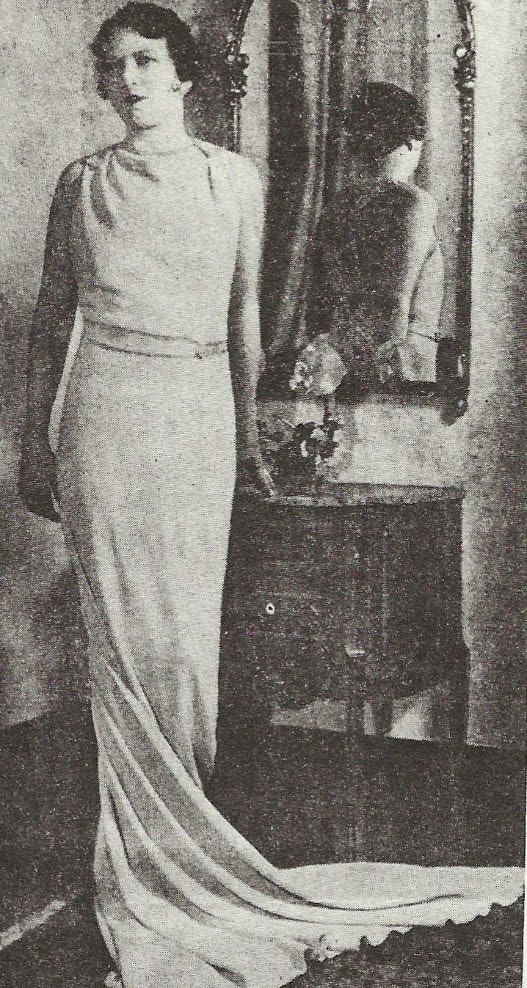The information below has been compiled from a variety of sources. If the reader has access to information that can be documented and that will correct or add to this woman’s biographical information, please contact the Nevada Women’s History Project.

Photo from the
Library of Congress
At a Glance:
Born: June 8, 1872, Dell Prairie, Adams, Wisconsin
Died: November 14, 1952, Washington, District of Columbia
Cemetery: Masonic Memorial Gardens, Reno, Nevada
Maiden Name: Mimosa June Gates
Race/nationality/ethnic background: Caucasian
Married: Key Pittman, July 8, 1900
Children: None
Primary city and county of residence and work: Washington, D.C.; Tonopah, Nevada; Dawson, Canada; Nome, Alaska; Eureka, California
Major Fields of work: U.S. Senator’s wife, founder of Senate Wives club, prominent hostess
Other role identities: Nature lover, dogsledder, prospector
From dogsledder to Washington hostess, Senator’s wife led a life of adventure
Mimosa June Gates Pittman was the wife of one of Nevada’s youngest and longest-serving U.S. Senators, Key Pittman, and a prominent Washington, D.C. hostess.
Mimosa was born June 8, 1872, to Kitty and Leroy Gates in Dell Prairie, Wisconsin. She was the second of four children (older sister Maude and younger brothers Humboldt and Edgar). While she and her siblings were still young, the family moved to Eureka, Calif., where the children grew up.
In January 1898, Mimosa boarded a steamship in San Francisco headed towards Alaska. By this time her parents were divorced and remarried to other spouses. Her mother, Kitty Hall, “was at the steamer to bid her a cheerful adieu.” In a January 1898 San Francisco Examiner article, Mimosa is quoted saying, “I’ve a half interest in a claim on El Dorado.” Humboldt had given her a half interest in his Klondike gold mining claim near the Alaska-Canada border.

From Key Pittman, the Tragedy of a Senate Insider,
by Betty Glad.
“My father [C.W. Hall] and two brothers, Humboldt and Edgar Gates, are in the mines and I’m going to join them.” The article went on to state, “Miss Gates departed with smiles wimpling all over her attractive face. She was self-reliant and perfectly confident of a safe and rather easy journey over that long way which so many robust men fear to tread.”
Mimosa was one of only two women in the group of prospectors on the steamer. During the Klondike-Yukon Gold Rush, out of the 100,000 hopefuls who started the trip up, only 30,000 of them ever made it. Mimosa was one of them.
By August 1898, Mimosa was in Dawson living with her brothers. One day while out mushing, Mimosa’s dogsled crashed into a sled driven by her future husband, Key Pittman. Their dog teams became entangled, maybe more than once. Key unraveled the dogs but then lit into the other driver. Mimosa erupted from her pile of fur coverings, and Key was taken aback. According to a 1937 San Bernardino Sun article, “An extremely pretty girl pulled down her cape and looked out. Pittman took one look, turned, and let his team, sled and all, slide down the icy hill into the creek.” Shortly after their crash, Key was knocking at Mimosa’s front door and their romance began.
In 1899, the gold rush moved to Nome, Alaska, and Key followed. In early 1900, Mimosa along with her brother Edgar and two guides, made the 48-day, 2,000-mile dog sled voyage from Dawson to Nome, arriving in April.
In a 1917 Alaska Daily Empire article, Mimosa stated, “I met him in Dawson, but when gold was discovered in the Nome district, he went there. I resolved to see Nome and of course Mr. Pittman and I made the trip by dog sledge. It was very interesting. People said it was wonderful of me to do such a thing, but I was younger … and Western air will make young people capable of doing most anything.”
According to a 1923 article in the Humboldt Times, Mimosa was “known to the early Klondikers in general as the first white woman, if not the only one, whoever drove her own dog team from Dawson to Nome over the winter trail.”
On July 8, 1900, in Nome, Key and Mimosa were married in a small private ceremony. According to a 1924 Evening Star article, “their wedding banquet consisted of canned pork and beans, crackers, dried tomatoes, and some thin pieces of chipped beef simmered in what passed for milk. It was a glorious feast and the prelude for Mrs. Pittman of the makeshifts to get an acceptable meal out of thin air.”
In September 1901, Mimosa took a steamer from Nome to San Francisco in order to avoid the Alaskan winter. Key followed in November, but he had to work as a sailor in order to catch the last boat out of Nome. They planned to return to Alaska in the spring. But the gold strike in Tonopah, Nevada, changed their plans. In January 1902, after an 18-hour frozen stagecoach ride, Key and his brother-in-law arrived in Tonopah. Mimosa followed in June.
In Tonopah, Mimosa and Key first lived at a hotel that was nothing more than “a wooden shack, great cracks between the wall partitions, so small in room space that Mrs. Pittman had to stand on her trunk to dress.” They later moved to a couple of different houses before building their own house.
In her book, Lady In Boomtown: Miners and Manners on the Nevada Frontier, Marjorie (Mrs. Hugh) Brown gives her first-person account of what it was like living in Tonopah during the early 1900s. “For the most part, Tonopah was a community of city people who lived in rough-board houses and walked unpaved streets, but who dressed as they would in San Francisco or New York.” The winters were cold, summers were hot, water was delivered once a week to fill up the kitchen water barrel, and cooking was done over wood stoves.
Tonopah life was full of social gatherings; dinners, parties, luncheons, meetings, neighbors just dropping by for the evening, and Mimosa either hosted or attended.
An example is detailed in a 1908 Tonopah Daily Bonanza article, “Merry maskers held sway at the home of Mr. and Mrs. Key Pittman on Tuesday night, and shouted, and cheered, and laughed, and blew out the old year and rang in the new. The occasion was the fourth anniversary of the Lunas Clava, of which Mrs. Key Pittman is the chief hostess.” The Lunas Clava was a women-only club, but the New Year’s Eve event was open to all.

Mimosa Pittman may be the woman on the far left.
Photo courtesy of the Nevada Historical Society.
On July 2, 1908, shortly after breakfast, a kitchen fire erupted at the Pittman house. According to the Tonopah Daily Bonanza, “Mrs. Pittman was quite severely burned about the hands and arms in extinguishing the fire which enveloped the cook. With a rare presence of mind, and disregarding her own safety, she rendered the unfortunate woman aid that probably saved her life.” Key got both women safely outside, and the house was lost to fire, but the quick-to-act neighbors were able to save the household valuables. The fire department responded quickly, but there was not enough water pressure to save the home. After the fire, the Pittmans moved into a nearby home and sent the volunteer fire department a note of thanks along with refreshments.
In her book, Marjorie Brown had this to say about Mimosa, “She had made an impressive journey by dog team down the Yukon trail from Dawson to Nome, an unbelievable feat if you look at the map. Her adventurous spirit captured the imagination of the soldier of fortune from Mississippi, but I was told by someone who had known her in Dawson that her friends thought it took more courage for her to marry Key Pittman than to face the Yukon trail. Be that as it may, to the very end of his life she was the only one who could control him when he went off the deep end. They were a glamorous pair.”

Photo from Washington Times, 1934
In 1912, Key Pittman was elected to the United States Senate. According to a Blue Lake Advocate article, “Mrs. Key Pittman, wife of the United States senator-elect from Nevada, is a former well-known Eureka [California] girl, when as Miss Mimosa Gates she was very popular in social circles. … As the wife of the new Nevada senator, Mrs. Pittman will become a member of the exclusive society set of Washington, D.C.”
In 1917, Mimosa founded the Senate Ladies Red Cross Unit (also known as “Ladies of the Senate”, “Senate Wives,” and today “Senate Spouses”). Originally created to aid in First World War efforts, the group expanded to include other charitable work and sponsors an annual luncheon for the First Lady.
Key served in the Senate for nearly three decades and the couple entertained extensively at their Washington D.C. residence.
A 1924 Evening Star article reported: “Senator and Mrs. Key Pittman are permanent denizens of Washington, and their home, Ridge Hall, … is usually one of the popular places where congress sits through the summer. Mrs. Pittman has already gone west, and after visiting friends and relatives in California she will join her husband in Tonopah, Nev. She has always been among the active hostesses of the senatorial set during the season.”
In Alaska, Mimosa acquired “a deep love for silent places and for long solitary trips on horseback and in canoes, which she retains. She frequently strolls for miles along the river off Conduit Road and into the deep woods which fringe it. She is an enthusiastic musician and a generous patron of all worthy musical crusades.” She “sings at home, for that was the great solace of her brothers and their friends during those shut-in weeks at Dawson, before they ventured forth to Nome.”
In her 1935 Honolulu Star-Bulletin article, Francis Keyes stated, “Ever since I came to Washington, Mimosa Pittman – “Peg” to her intimates – has been one of my kindest and most cherished friends. The rare grace of her carriage and figure and the sweetness of her smile have always commanded my admiration; but I have rejoiced even more in the constancy of her cordiality. Over and over again, at the end of a hard day’s work, I have turned to her hospitable hearth for relaxation and refreshment. Always I have found a warm fire and a warm welcome waiting for me. Always I have known I could count on the steadfastness and sincerity of her affection.”
In 1938, Mimosa was one of a select number of women leaders to be on the planning and operating committee for the 1939 New York World Fair. At the 1939 Congressional welcoming reception for King George VI and Queen Elizabeth, Mimosa Pittman was the only senatorial wife to be included. Mimosa and Key, chairman of the Senate Foreign Relations committee, attended all four of the formal events honoring the British Royals.
After Key’s death in November 1940, Mimosa worked on establishing a memorial for her late husband. Key wanted to be buried on a mountaintop where he could see in every direction. Their crypt can be found high on the hill of the Masonic Memorial Gardens in Reno, Nevada.
Mimosa kept both the Tonopah, Nev. and Washington, D.C. homes after Key passed, though she spent most of her time in Washington. Mimosa passed away at her Washington, D.C. residence on November 14, 1952, at the age of 80.
Researched by Patti Bernard and Catherine Cuccaro. Written by Catherine Cuccaro
Posted November 2022
Sources of Information:
- Ancestry.com. Year: 1880; Census Place: Dell Prairie, Adams, Wisconsin; Roll: 1417; Page: 17B; Enumeration District: 003. [Mymona Gates]
- Ancestry.com. Year: 1910; Census Place: Tonopah Precinct 2, Nye, Nevada; Roll: T624_859; Page: 11A; Enumeration District: 0058; FHL microfilm: 1374872. [Mimosa G Pittman]
- Ancestry.com. Year: 1930; Census Place: Tonopah, Nye, Nevada; Page: 13B; Enumeration District: 0020; FHL microfilm: 2341032. [Mifofa Pittman]
- Ancestry.com. Year: 1940; Census Place: Tonopah, Nye, Nevada; Roll: m-t0627-02279; Page: 61B; Enumeration District: 12-9. [Mimosa Pittman]
- Mrs. Hugh [Marjorie]. Lady in Boomtown: Miners and Manners on the Nevada Frontier. Palo Alto, Calif.: American West Publishing Company, 1968, p. 41, 52-53, 58, 87-88.
- “Cream Of County News.” Blue Lake Advocate (Blue Lake, California), Volume XXV, Number 42, 1 Feb. 1913, p. 7.
- “Find-A-Grave”, database, Find-A-Grave www.findagrave.com. Find-A-Grave memorial https://www.findagrave.com/memorial/150451370/mimosa-june-pittman, Accessed 1 June 2021. [Mimosa June Gates Pittman]
- Glad, Betty. Key Pittman, the Tragedy of a Senate Insider. New York, NY: Columbia University Press, 1986.
- “Home of the Pittman’s, Long a Social Center, Is Closed for Summer.” Evening Star (Washington, DC), 15 June 1924, p. 57.
- “In The Klondike.” Humboldt Times (Eureka, California), Vol. LI, Number 34, 10 Aug. 1898, p. 4.
“Key Pittman’s Residence Burns.” Tonopah Daily Bonanza (Tonopah, Nevada), 3 July 1908, p. 2.
Keyes, Francis Parkinson. “The Log of a Senator’s Wife.” Honolulu Star-Bulletin (Honolulu, Hawaii), 2 Mar. 1935, p. 5.
“Life Story of the ‘Silver Senator.’” Nevada State Journal (Reno, Nevada), 1 Nov. 1934, p. 10. - “Local News.” Ferndale Enterprise (Ferndale, California), 27 July 1900, p. 4.
- “Marriage of Miss Mimosa Gates.” Humboldt Times (Eureka, California), Volume LV, Number 43, 21 Aug. 1900, p. 2.
- “Merry Maskers Held Full Sway.” Tonopah Daily Bonanza (Tonopah, Nevada), 2 Jan. 1908, p. 4.
- “Mrs. Pittman At Royal Reception.” Reno Evening Gazette (Reno, Nevada), 9 June 1939, p. 12.
- “Mrs. Pittman Is A Real Westerner.” Alaska Daily Empire (Juneau, Alaska), Vol:10, Issue:1514, 29 Sep. 1917, p. 5.
- “Mrs. Pittman Tells of Desire of Husband for Memorial Shaft.” Nevada State Journal (Reno, Nevada), 13 Dec. 1940, p. 2.
- Pearson, Drew and Allen, Robert S. “Washington Merry-Go-Round.” San Bernardino Sun (San Bernardino, California), Volume 43, 12 May 1937, p. 13.
- “Plan Memorial for Pittman.” Reno Evening Gazette (Reno, Nevada), 27 Feb. 1945, p. 15.
- Rowley, Gladys. “Reno Revue.” Nevada State Journal (Reno, Nevada), 14 Aug. 1938, p. 10.
- “Senator’s Wife Daring Woman Early Klondiker.” Humboldt Times (Eureka, California), Volume LXXXVI, Number 25, 29 Sep. 1923, p. 1.
- “Sen. Key Pittman’s Widow Laid to Rest.” Nevada State Journal (Reno, Nevada), 20 Nov. 1952, p. 7.
- “Sen. Pittman Lauded in Press Story as He Prepared To Meet British King.” Nevada State Journal (Reno, Nevada), 14 June 1939, p. 6.
- “To Seek Fortunes. Gold Hunters Sail on the Excelsior.” The San Francisco Examiner (San Francisco, California), 19 Jan. 1898, p. 2.
- “United States Senate, Traditions & Symbols, Senate Spouses Organization.” https://www.senate.gov/about/traditions-symbols.htm, Accessed October 4, 2022.
- “Widow Of Former Nevada Senator Succumbs.” The Times Standard (Eureka, California), 15 Nov. 1952, p. 20.
- “Widow of U.S. Senator Passes.” Reno Evening Gazette (Reno, Nevada), 14 Nov. 1952, p. 13.

